Is a Dyper.com diaper subscription worth it?
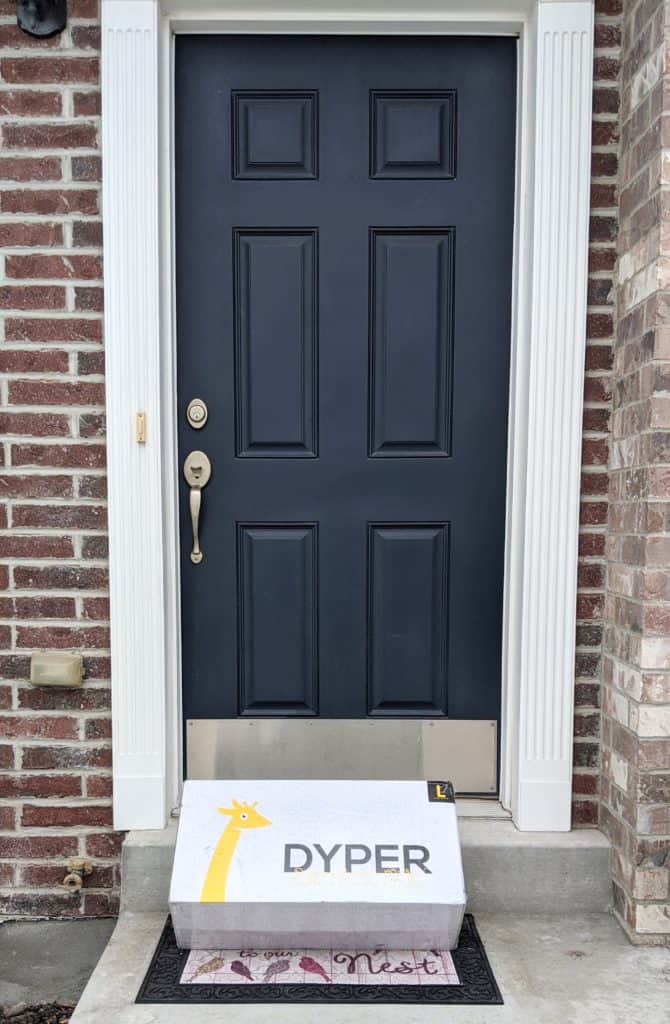
If you like less chemicals on your baby’s bum, less diaper rash and a more sustainable eco-friendly product, then the answer is YES!
I have now received over 10 shipments of eco-friendly bamboo diapers and I plan on keeping my subscription going.
Before I had kids, I really wanted to use cloth diapers,. After kids, I tried to use cloth diapers, but the time and effort to do so stretched me too thin while I was recovering from childbirth and raising a baby that didn’t (and still doesn’t) sleep well.
So what is the next best option? Eco friendly diapers.
Can disposable diapers be eco friendly? Maybe not technically since they are disposable, but Dyper.com diapers are helping bridge the divide between brands like Huggies and cloth diapers.
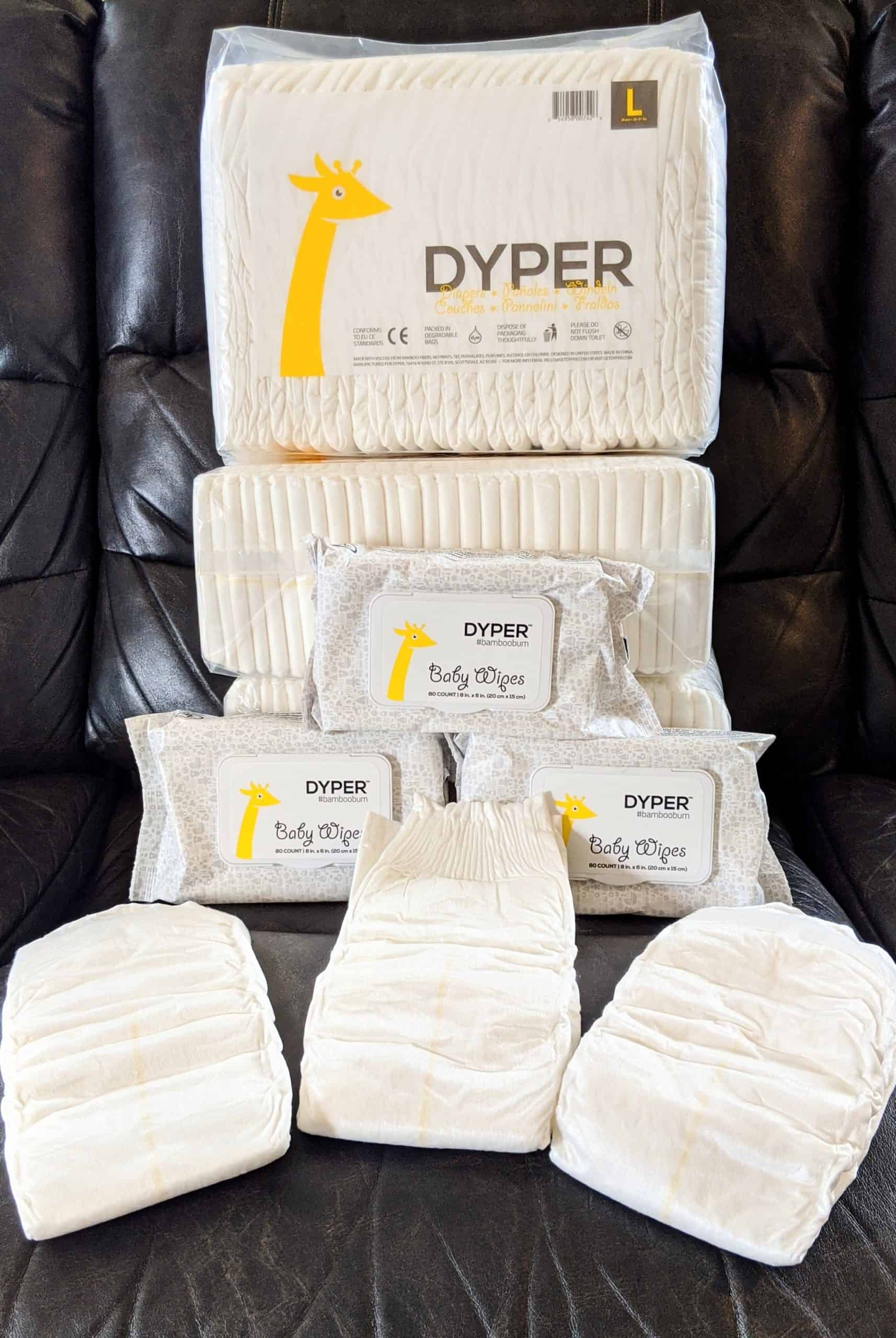
How well do Regular Dypers work?
To break it down, on a scale of 1 to 10, here are my ratings:
Quality-9
Performance (Absorbency, Sturdiness)-9
Feel/Texture-9
Gentleness next to skin (less toxic ingredients)-9
Fit-7
Ease of ordering-9
Thriftiness-6
Overall I would rate this diaper an 8.29 out of 10.
Quality and Performance: These are very good diapers. They feel like they are made of quality materials. They are highly absorbent. I’ve had very few leaks or blowouts with them. They go up high in the front and back so nothing escapes.
They are sturdy after a lot of use. Although, if they are really wet the tabs sometimes come apart from the diaper when removing the diaper. I haven’t had it come apart while my daughter was wearing it.
Gentleness: The materials seem to be gentle on my child’s skin. She has very sensitive skin and has had much less diaper rash now that we’ve been using these diapers (and wipes) almost exclusively.
Fit: The fit of the diaper could be improved. Like I said it’s high in the front and back, that is good. I wish the sides were a little wider though. See the photos comparing Dyper with Huggies. You can see that Huggies is wider as it wraps around and overall. The fit of the Dyper is still decent, but you have to work harder at positioning the diaper so that the tab on one side doesn’t dig into the skin.
I will say here that since my first post they have developed an extra wide and extra absorbent diaper to their line, Dyper X. They cost $10 more a month than the regular kind. I haven’t tried them, but am thinking about it.
Ease of Ordering: Signing up for Dyper and making changes to your order is pretty easy. There is also a Dyper app which makes things very simple. You even receive an email a week or so before another shipment is processed. This gives you plenty of time to move the date back if your diaper supply is enough.
Thriftiness: I gave thriftiness the lowest ranking. My daughter is in a size Large which cost 49 cents each (see cost breakdown further on in the post). To me this is expensive. It may be very affordable for some, especially depending on where you live, but it is higher than most grocery store diapers. Buying Kirkland brand diapers from Costco cost about 38 cents a diaper, lower if I could get them on sale. Over time this 11 cents can add up.
Even with the price and fit issues, the quality, non-toxicity and eco-friendliness of the Dyper will keep me buying their product.
How much do Dyper brand diapers cost?
Dyper charges a flat fee of $68 (for all sizes) for 4 sleeves of regular diapers when your order is reoccurring. Also if you add wipes with your order they are $5 for each package. (These prices haven’t changed the whole time I have been ordering from them, which is awesome.)
They once used only a subscription model, but now you can buy your orders one at a time and in 2, 3 or 4 sleeve quantities. Of course ordering this way is 15% more expensive. With the subscription you can cancel any time or delay your order whenever you need to. You only pay for one month at a time.
Really get the subscription, it will save you in the end. You can also set your new subscription to a future date if you’re not ready to start right now. You’re not charged until the diaper shipment has been sent.
The number of diapers in an order depends on the diaper size
Size, diapers per order and price each:
- Newborn – 260 diapers, 26 cents each
- Small – 220 diapers, 31 cents each
- Medium – 180 diapers, 38 cents each (rounded up)
- Large – 140 diapers 49 cents each (rounded up)
- XL – 100 diapers, 68 cents each
Although you get less diapers in the larger sizes, you probably know that kids don’t need changing as much as they get older, so it evens out. We’re using the large size now. On average we use 4.5 diapers a day. That’s $2.48 per day. $903 for the year.
Yes these diapers are more expensive than Costco’s brand or Huggies, but they are way more eco-friendly and in my opinion just an overall better diaper. So, you’re paying more for less impact on the environment, no toxins against your baby’s bum, and as I mentioned before, less blowouts!
Dyper vs. Huggies
I’ve taken several side by sides photos to compare regular Dyper diapers with Huggies Little Movers Plus (done in March 2020).
For starters, Huggies has a print and Dyper is white with no print, only a small yellow wetness indicator line. I actually like not having a print on diapers. When my child wears white tights or leggings a print isn’t showing through.
As you can see they are comparable in size. The Huggies diaper is much stretchier. That’s not always a good thing when your trying to change a wiggly baby’s diaper. I like that Dyper lays out flatter.
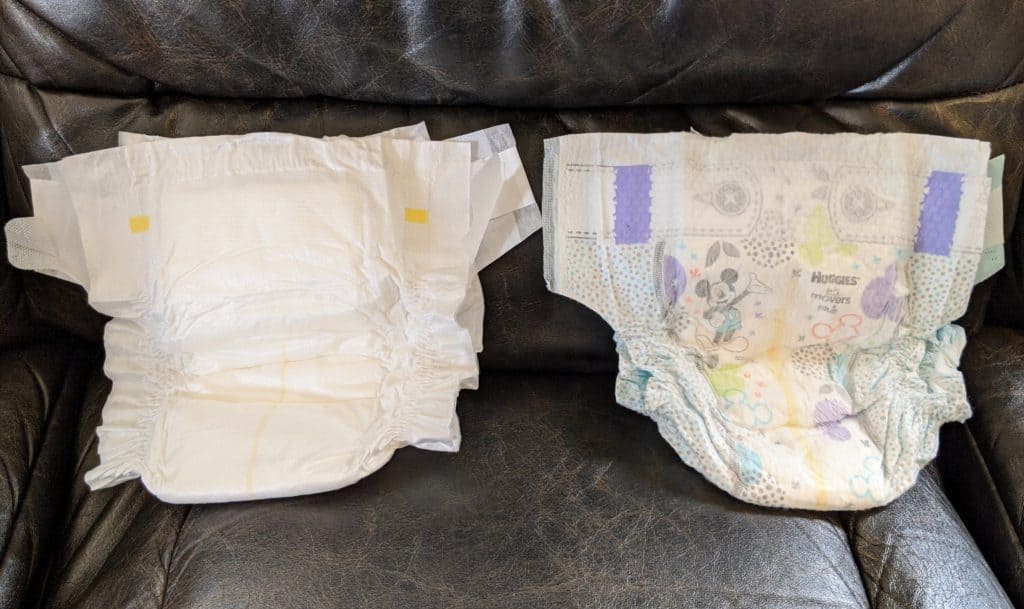
They are pretty much the same length when stretched. Dypers definitely go up high in the front and back. Although they are the same length, Huggies seems to not go up as far because the stretch bunches them down a bit.
What I do like better about Huggies is their width. They are wider at the tab area in front and back. Huggies is on bottom, Dyper on top.
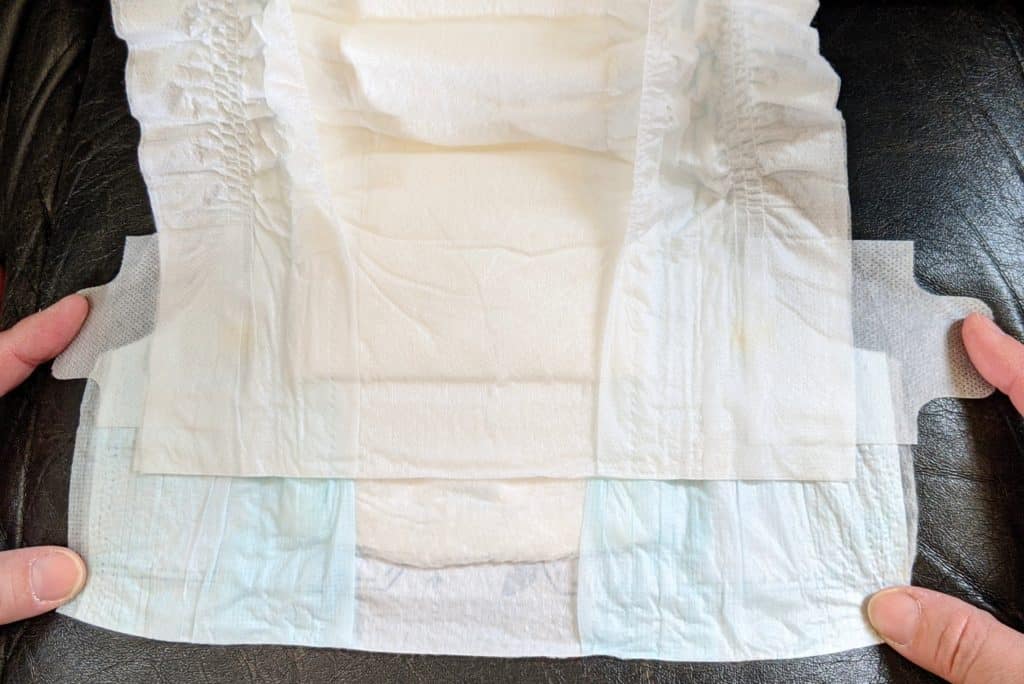
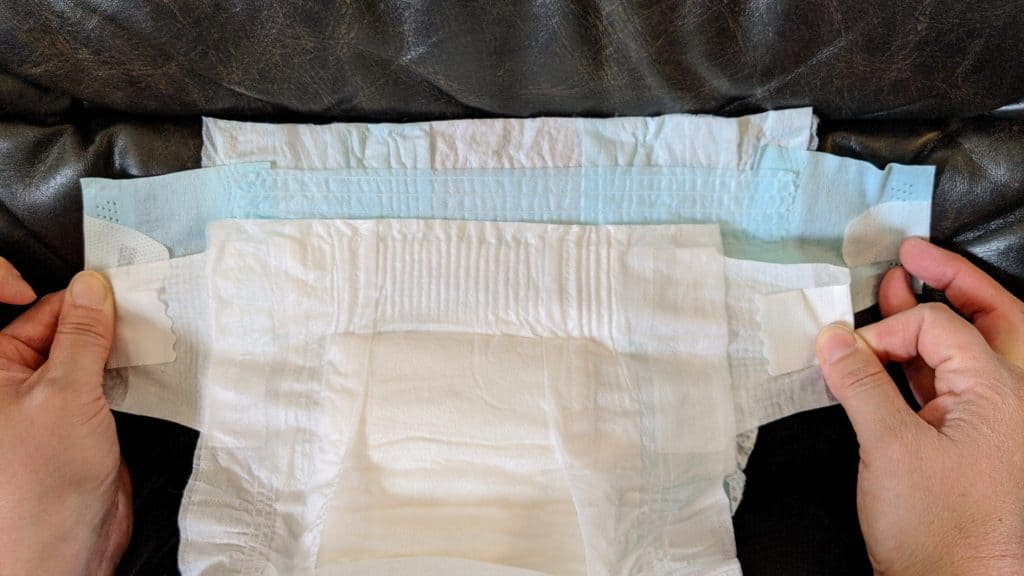
What are they made from (or without)?
They are made from responsibly sourced viscose bamboo fibers. They are free of chlorine, latex, TBT, phthalates, alcohol, lotions, perfumes or ink.
So why bamboo?
Bamboo is a grass. It grows fast, doesn’t require fertilizer and can be processed with less chemicals. When Dyper says responsibly sourced, I assume they mean from eco friendly bamboo farms and not from the wild.
The clear bags they package the diapers in are made from oxo-degradable materials. I’m assuming this means oxo-degradable plastic. There is debate over whether this kind of plastic (that breaks down fairly quickly into much smaller pieces of plastic) is eco friendly or not.
Carbon offsets
When you purchase diapers from Dyper, part of your purchase price includes carbon off-set credits. This covers pollution caused by the manufacturing, shipping and disposing of their diapers.
Dyper even gives you a proof of support certificates for each order. Each order offsets 18.3 kg of CO2 with offset purchases from Cool Effects, Inc.
This carbon offset company looks amazing. Purchasing offsets from them funds conservation, reforestation and pollution reduction projects.
Take for instance this project in Uganda that helps families get more efficient, locally made cookstoves. More efficient stoves mean money savings on fuel for families, less trees felled for fuel and less carbon emitted into the air. It really is the little things. So inspiring!
5 orders offset 91.5 kg of CO2. You can also buy credits as an individual to offset your own personal carbon footprint. I recently bought offsets from this company on Giving Tuesday.
Can I compost these diapers?
If you’re a gung-ho composter you can remove the tabs and throw your non-poopy diapers in with compost that you will use for ornamental plants (not vegetables, herbs, fruit plants, etc.).
Poopy diapers on the other hand have to be commercially composted. I know this sounds a little gross, but really it’s all organic matter that breaks down just like banana peels, albeit much slower.
In some major cities local companies like EarthBaby and Blessed Bums will take away your used diapers to be recycled.
Alternatively, if you live in the US, you could opt for Dyper’s new recycling program, ReDyper. Dyper provides you with bags, boxes and a prepaid shippping label to ship your used diapers to TerraCycle and have them composted. At $39 a box (at least it was, I can’t find a more recent price), the fee is steep, but it may be worth having a lighter conscience.
What else does Dyper sell?
Since I first reviewed Dyper they have added a lot more products to their website. They now sell the extra wide and absorbent, Diaper X and a diaper brief (I haven’t tried either yet). At the time of my first post they sold their own wipes, diaper cream, diaper pail, and diaper bag, they now also sell a baby carrier, baby body wash, a diaper caddy, hand sanitizer and diaper sensors.
Yes, you read that right, diaper sensor devices, called Sense. They’re just what they sound like, a sensor you stick on your baby’s diaper that alerts you when it’s time to change the little tyke. The idea is this will help you optimize your diaper usage. Dyper has tested them for safety.
I have only tried the wipes, so I can’t review those. I would like to try the body wash though.
What are the Wipes like?
Wipes: I’ve really come to like these wipes. They are made from viscose bamboo and mostly water. They are different from regular wipes. They’re a bit smaller and not as wet, both good things.
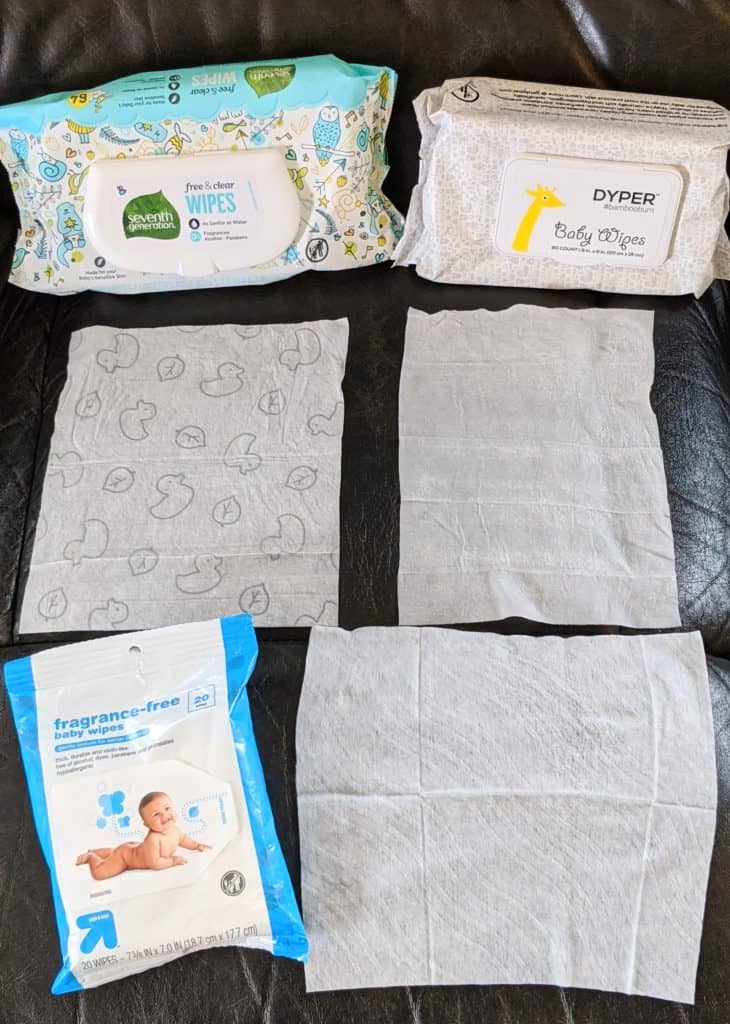
First, if you just need to do a little wiping you just use one and it’s smaller so less waste.
Second, they don’t leave my daughter’s bottom very wet which means less diaper rash! Before we’d have to wipe with a regular wipe and then dry with a tissue. So much easier this way.
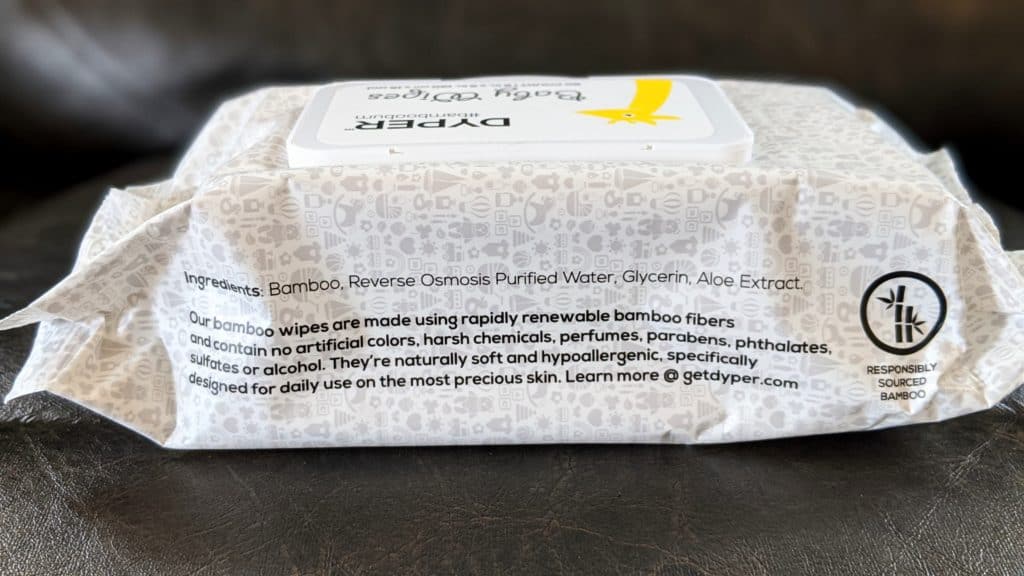
Also the ingredients are very simple. They used to just have 4 ingredients, but they have changed their formula since my first post. I’m not really happy about that, but my child didn’t have any reaction to the new wipes, so that’s good. They contain 99% water and also glycerin, chamomille extract, tocopheryl acetate, aloe extract, decyl glucoside, benzethonium chloride and citric acid. At least there is no sodium benzoate.
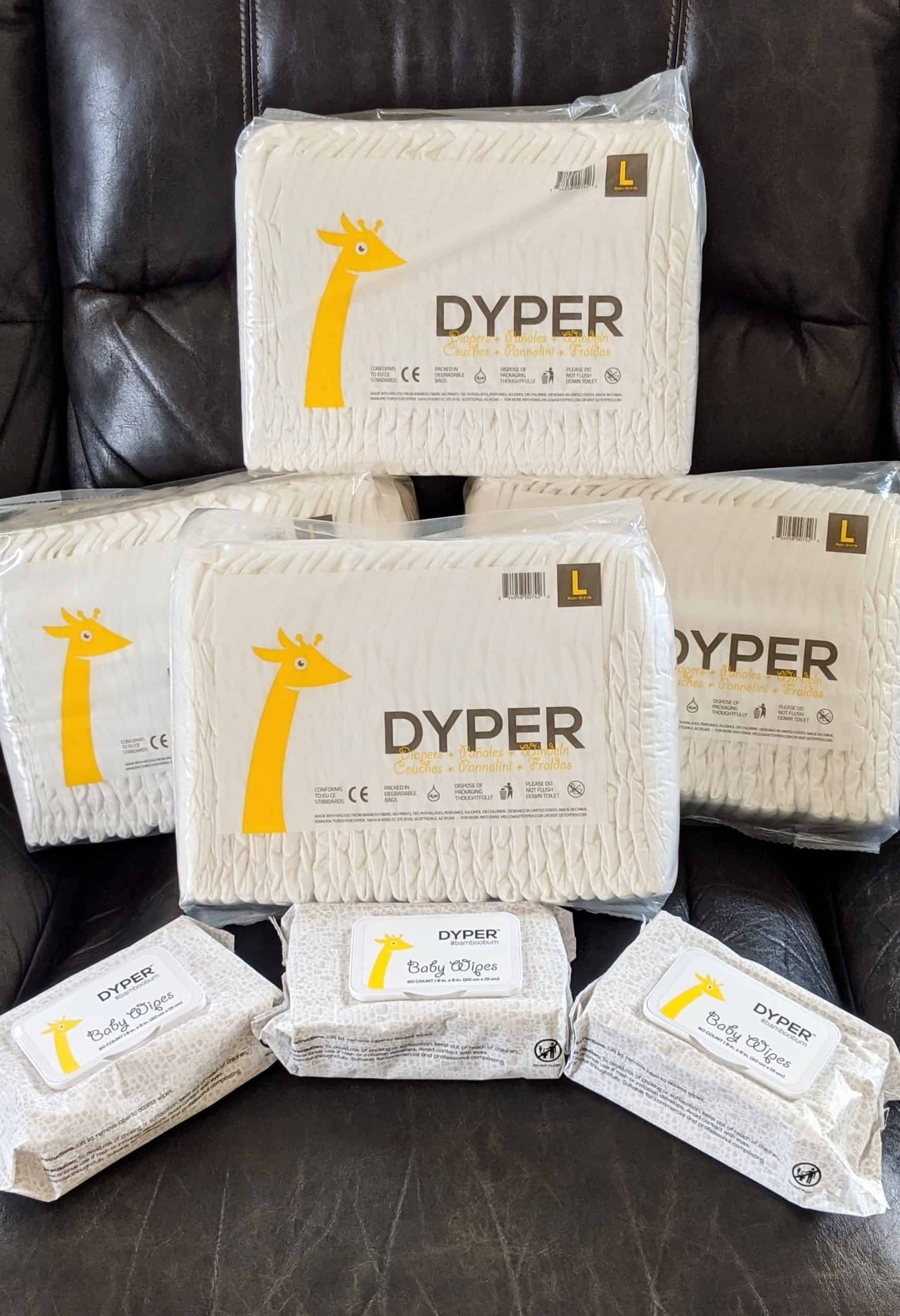
What is the cost of wipes?
The first 3 packs of wipes you order with your monthly shipment are only $5 each. If you need more, which I frequently do, the cost is $8 each. But you’ll have to order a four pack for $32. Each package has 80 wipes. This comes out to just over 6 cents a wipe (rounded down in price) at $5 per pack and 10 cents a wipe per $8 pack.
I use 3 wipes for a big messy diaper and 1 wipe for just a wet diaper. I use about 9 a day, that equals 54 cents a day and $197.10 a year. So, all in, that comes to about $1100 a year for diapering for my one child.
So, how does the Dyper subscription service work?
It’s pretty easy.
First, sign up online. When you do, you’ll simply choose a day you want your diapers to be shipped and when you want them automatically reordered and shipped. You can modify this for future orders if need be. Then you pick your size and if you want wipes included with your order.
That’s it!
Have you used the Dyper subscription service? Let me know what you thought in the comments below!

